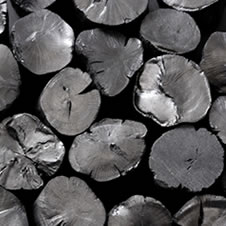1.Types of Charcoals
Charcoals can be divided into two main types : hard and large "white charcoal" and "black charcoal" which is softer. White charcoal is made by carbonizing the original wood at a low temperature for many hours. Toward the end of the process, the kiln entrance is open wide to admit fresh air at once, raising the kiln temperature to approximately 1000℃. The charcoal is then pulled out of the kiln and covered in damp mixture of earth and ash, to stop it from burning into ash. The damp mixture leaves white marks on the surface of binchotan, hence the name "white charcoal". Binchotan is the finest example of white charcoal. "Black Charcoal", on the other hand, is carbonized at temperatures between 600 and 700℃, and the process is terminated by sealing the kiln both at the entrance and at the flue to shut off the air to stop the burning. Slow cooling process is said to result in better quality of black charcoal.
2.Selecting Good Binchotan
 Here are some tips for selecting a good quality binchotan.
Here are some tips for selecting a good quality binchotan.
The cut surface shines like black diamonds.
Gives out the least amount of black dust when you touch.
Gives out a metallic sound when you hit them.
Place of Origin is clearly indicated.
Among those generally available in Japan, there are Kishu-binchotan (Wakayama Prefecture), Tosa-binchotan (Kochi Prefecture), Hyuga-binchotan (Miyazaki Prefecture), Chugoku-binchotan (PROC), Nanyo-binchotan (Southeast Asia).
Forestry Cooperative of Minabe-kawa Website has more details about Binchotan. (in Japanese Language Only)